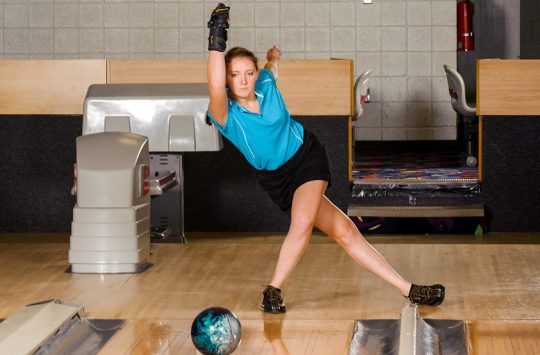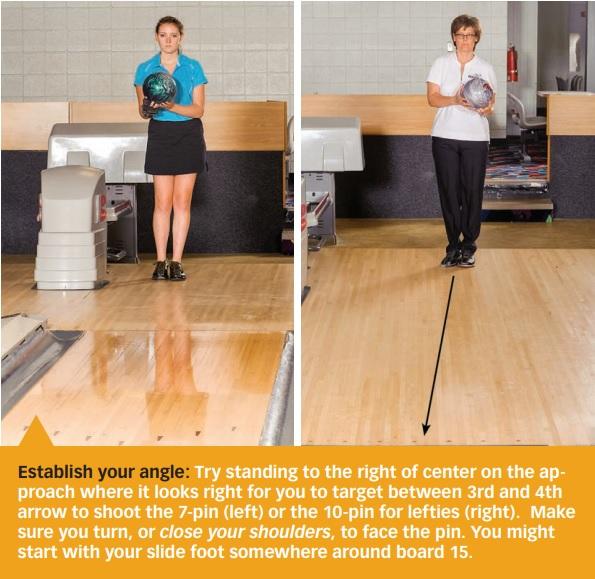Why It's Time to Consider Using Plastic for the 'Other' Corner-Pin Spare

BY MICHELLE MULLEN
In an earlier column on picking up the 10-pin (or the 7-pin for left-handed bowlers), I suggested using a plastic ball. But there are three reasons to also consider using a plastic ball when attempting to convert the 7-pin (or the 10-pin for lefties).
For one, on today’s typical house shot (THS), the lanes are oiled differently than when the blended oil pattern prevailed and the conventional “3-6-9 spare system” worked flawlessly. On the blended pattern, the oil gradually kept increasing toward the middle of the lane, whereas now the oil abruptly increases to create a more defined oil line between the oily and dry boards. This creates a much less predictable reaction as the ball crosses from the dry boards through the much oilier part of the lane.
Secondly, you might bowl on many different lane conditions, experience inconsistent conditions in league from week to week, or have a variety of strike balls in your arsenal. This can make it challenging to shoot spares on the left side, leaving you to guess how much your ball will hook toward the spare.
Finally, it is difficult to use the 3-6-9 system to pick up left-side spares when you have to play far outside on the lane (as in the first arrow). You simply don’t have enough room to move several boards to the right from your strike position to pick up the 7-pin.

When you get tired of guessing how much to adjust or running out of room, consider using a plastic ball to shoot directly at the 7-pin. It is an excellent strategy to take reaction out of the equation by creating an angle independent of lane conditions and ball reaction.
Since you will be using a separate ball altogether, determining where to stand will not depend upon your strike position. Just as you established an optimal angle toward the 10-pin using an arbitrary angle (independent of the strike line), so it will be for the 7-pin.
However, establishing where to stand for the 7-pin is a little trickier, given that your shoulders will be closed to face the pin on the left side of the lane. Since your swing is on the right side of your body and your shoulders are closed, you will actually walk slightly toward the target to keep your swing on the target line. Determining where to stand will depend on how much you walk toward your target as you keep your shoulders closed throughout the approach to face the spare.
Establish your angle. Try standing to the right of center on the approach, where it looks right for you to target between the third and fourth arrow to shoot the 7-pin. Make sure you turn, or close your shoulders, to face the 7-pin (figure 11.4). You might start with your slide foot somewhere around board 15.
Where to stand for this side is less clear because, unlike the 10-pin shot, you will drift slightly toward the target to keep your shoulders closed and the swing lined up to the target line. So, the amount of your drift will affect where you have to start on the approach. This varies from bowler to bowler. If you drift more, you might start more to the right. If you drift less, you will start more to the left. You will end up somewhere around the middle dot at the foul line.
It may sound a bit contradictory to the notion of walking straight, but you do not walk straight when your shoulders are closed, aligned to the 7-pin. Because your armswing is on the right side of your body, you need to walk toward your target to keep your swing on the intended target line toward the 7-pin, and still follow through at a 90-degree angle to your shoulders.
(Note: To be consistent on the concept of drift, never drift toward your armswing. You will walk straight or slightly away from your swing as you drift left toward your target to keep your swing perpendicular to the shoulders and lined up to the desired target line.)
Close your shoulders. The plastic ball does not hook, so you are throwing it directly at the pin. Adjust your stance to close your shoulders toward the pin, also closing up your hips and feet so as to face the target line. Avoid twisting your upper body toward the spare. This helps your spine stay relaxed and makes it easier to stay in alignment throughout the approach.
Closing your shoulders to face the spare will line up your swing directly at it. Closing your shoulders can be a very awkward feeling at first. This is because on all other shots, your shoulders are either parallel to the foul line or slightly open, as when you throw a hook ball or when you shoot at spares on the other side. It feels odd to close your shoulders because it is so different from what you are accustomed to doing on all other shots.
 Maintain Shoulder Angle: Once you preset your shoulders in the stance to face the spare, make sure your shoulders do not open during the approach. The key is to set your shoulders in position and lock your core in place to face the spare throughout the entire approach. Even as the momentum of the swing passes your body, do not let the force turn your shoulders. If you do, your shoulders will open and your swing will no longer be lined up to get the spare.
Maintain Shoulder Angle: Once you preset your shoulders in the stance to face the spare, make sure your shoulders do not open during the approach. The key is to set your shoulders in position and lock your core in place to face the spare throughout the entire approach. Even as the momentum of the swing passes your body, do not let the force turn your shoulders. If you do, your shoulders will open and your swing will no longer be lined up to get the spare.
Be sure to maintain your shoulder angle. Once you preset your shoulders in the stance to face the spare, make sure your shoulders do not open during the approach.
The key is to set your shoulders in position and lock your core in place to face the spare throughout the entire approach. Even as the momentum of the swing passes your body, do not let the force turn your shoulders. If you do, your shoulders will open and your swing will no longer be lined up to convert the spare.
Overcome obstacles. Forget about any notion to open your shoulders or stay parallel to the foul line. In fact, how it feels to close the shoulders is the greatest obstacle I see bowlers face, and is typically why so many end up abandoning this strategy. It simply feels weird at first to stick to it and benefit from the advantages of shooting directly at the spare— that, and how different it is to see the ball go so straight.
In fact, many bowlers are not actually facing the spare like they think they are. I can’t tell you how many times I’ve had to stand behind the player to line them up properly. Where they think they are facing and where they actually are facing often are two very different things.
Almost everyone who tries this for the first time feels as though they are facing the wall, but rest assured, you are not. It is just that the feeling of closed shoulders
feels so drastically different from what you are used to on all other shots. The most closed you will ever have to be is when shooting the 7-pin (or the 10-pin, if you are left-handed) with a plastic ball.
When I first learned to use this system, I always felt as though I wanted to pull the ball across my body when my shoulders were closed. It is simply a matter of getting used to turning your body, but still following through with your swing at a 90-degree angle to your shoulders.
So often, it only takes going directly toward a spare with a plastic ball in league play and missing it to make a bowler want to quickly abandon the system. This is especially true when pushed over the edge by a coach or teammate who comments, “If you would have hooked at it, you would have gotten it!”
I beg to differ. The spare was missed because something went wrong in the execution. Rather than give up on it, you just need to execute better or adjust your angle. It takes practice to get comfortable executing at this direct angle.
I really believe that using a plastic ball is the way to go. There is a reason professional bowlers go more directly at spares, whether they flatten their wrists or use a spare ball: It is to take the lane pattern out of play.
This is how I shot my spares on tour, and it is why I added a new chapter on spare shooting in my latest book. I believe that getting used to how it feels and seeing your ball “go direct” is a small price to pay for the success you will have making more spares.
Commit and become proficient at shooting straight at your spares. You may have to be a bit more accurate, but the advantages outweigh the challenges to change. I encourage you to stay the course. After all, if pros go straight at their spares, it just might be a good idea.
Michelle Mullen is a USBC Gold-level coach and the author of two books, “Bowling Fundamentals” and “How to Pick Up Spares.” Her instructional column, "Foundation Frame," appears bimonthly in Bowers Journal International. To subscribe now for much more of the industry's best coverage of bowling news and incisive instructional tips and analysis, go here: /bowlers-journal-subscriptions/





